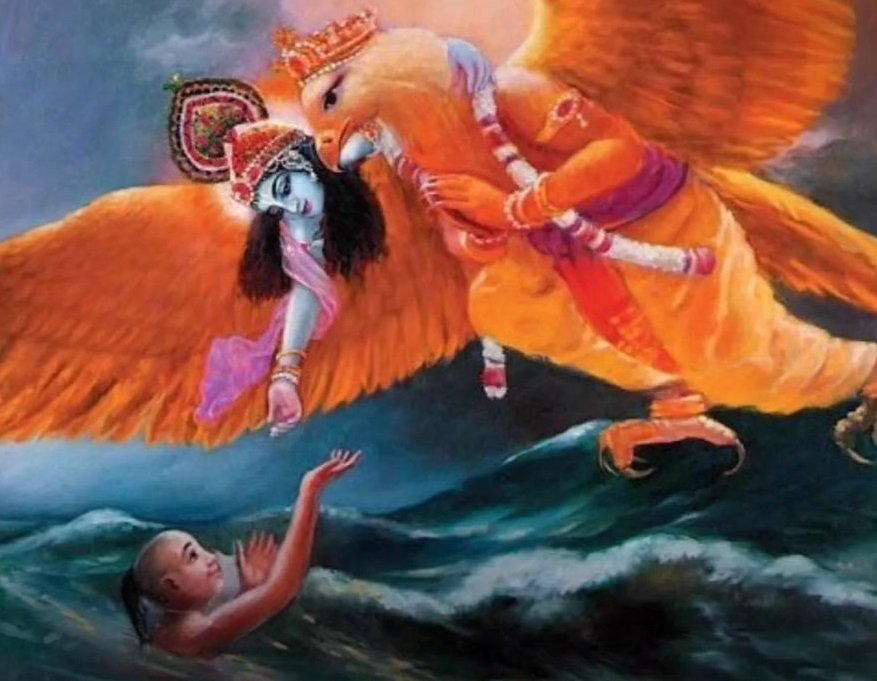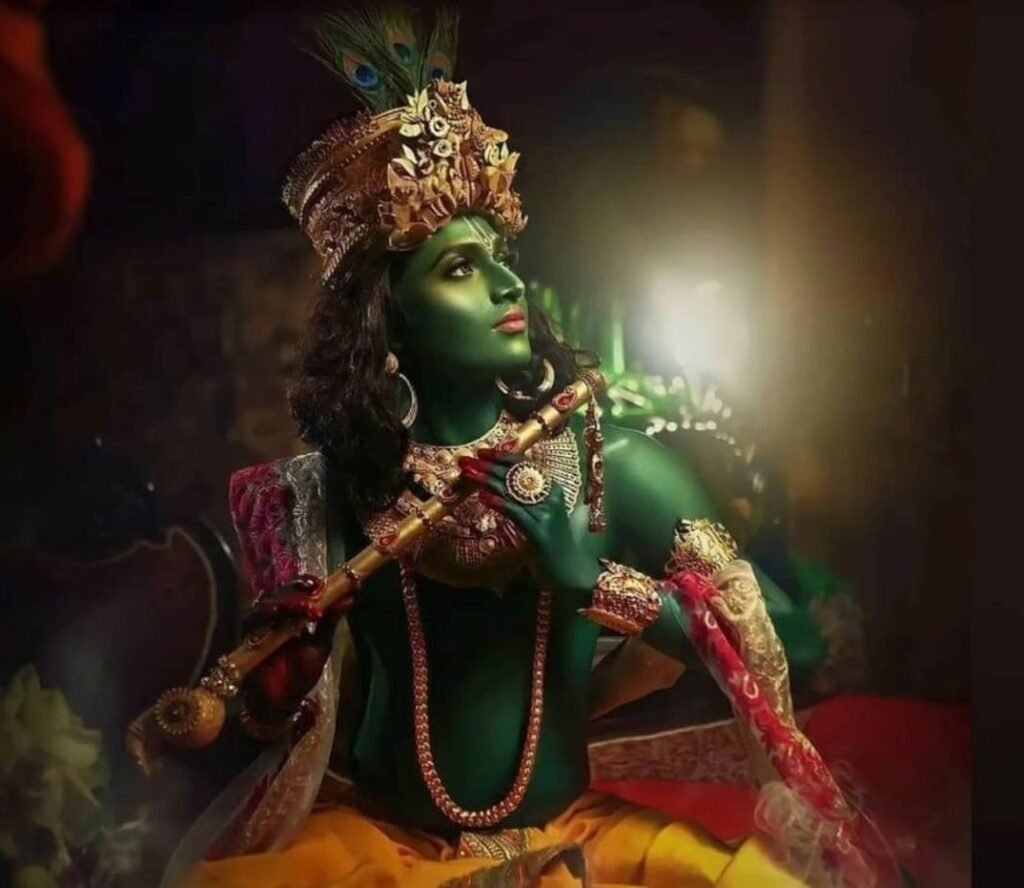Bhagwat Geeta Chapter 2 Shlok - 18
The physical body, in its gross form, indeed originates from mud. This transformation unfolds through the progression of mud into various forms such as vegetables, fruits, grains, lentils, and grass. Cows, consuming the grass, produce milk, which becomes part of the human diet and contributes to the formation of the body. Therefore, asserting that the body is created from mud is not an exaggeration but a reflection of the intricate cycle of life.
Upon the departure of the soul at the time of death, the body undergoes one of three possible fates: kṛimi (burnt), viḍ (buried), or bhasma (thrown into the river). Burning the body results in its conversion to ashes, akin to mud. Burial leads to the decomposition of the body by insects, eventually transforming it into mud. Alternatively, when the body is disposed of in a river, sea creatures consume it, excreting waste that merges with the mud on the seabed. In each scenario, the body ultimately returns to the earth, completing a remarkable cycle involving mud.

Picture credit:-@krishna.paramathma
This cyclic transformation finds resonance in various religious texts, such as the Bible’s statement, “For dust thou art, and unto dust thou shalt return” (Genesis 3:19), which alludes to the material nature of the body. Shree Krishna imparts a similar wisdom to Arjun, emphasizing that within the material body resides an eternal, imperishable entity that transcends the mud-like nature of the physical form. This eternal entity, identified as the divine soul or the real self, stands apart from the transient material elements that compose the body. In this way, Shree Krishna draws attention to the profound distinction between the perishable body, rooted in the elements of the earth, and the immortal soul, which exists beyond the material realm.

Picture credit:-@krishna.paramathma
भौतिक शरीर, अपने स्थूल रूप में, वास्तव में मिट्टी से उत्पन्न होता है। यह परिवर्तन मिट्टी के सब्जियों, फलों, अनाज, दाल और घास जैसे विभिन्न रूपों में बढ़ने के माध्यम से प्रकट होता है। गायें घास खाकर दूध का उत्पादन करती हैं, जो मानव आहार का हिस्सा बनता है और शरीर के निर्माण में योगदान देता है। इसलिए, यह कहना कि शरीर मिट्टी से बना है, कोई अतिशयोक्ति नहीं है बल्कि जीवन के जटिल चक्र का प्रतिबिंब है।
मृत्यु के समय आत्मा के चले जाने पर, शरीर तीन संभावित भाग्यों में से एक से गुजरता है: कृमि (जला हुआ), विद (दफनाना), या भस्म (नदी में फेंक दिया गया)। शरीर को जलाने से वह मिट्टी के समान राख में परिवर्तित हो जाता है। दफनाने से शरीर कीड़ों द्वारा सड़ जाता है और अंततः कीचड़ में बदल जाता है। वैकल्पिक रूप से, जब शव को नदी में बहाया जाता है, तो समुद्री जीव इसे खा जाते हैं, जिससे अपशिष्ट उत्सर्जित होता है जो समुद्र तल पर कीचड़ में मिल जाता है। प्रत्येक परिदृश्य में, कीचड़ से जुड़ा एक उल्लेखनीय चक्र पूरा करते हुए, शरीर अंततः पृथ्वी पर लौट आता है।
यह चक्रीय परिवर्तन विभिन्न धार्मिक ग्रंथों में प्रतिध्वनित होता है, जैसे बाइबिल का कथन, “तू मिट्टी ही है, और मिट्टी में ही फिर मिल जाएगा” (उत्पत्ति 3:19), जो शरीर की भौतिक प्रकृति की ओर संकेत करता है। श्री कृष्ण अर्जुन को एक समान ज्ञान प्रदान करते हैं, इस बात पर जोर देते हुए कि भौतिक शरीर के भीतर एक शाश्वत, अविनाशी इकाई निवास करती है जो भौतिक रूप की मिट्टी जैसी प्रकृति से परे है। यह शाश्वत इकाई, जिसे दिव्य आत्मा या वास्तविक स्व के रूप में पहचाना जाता है, शरीर की रचना करने वाले क्षणिक भौतिक तत्वों से अलग है। इस प्रकार, श्री कृष्ण पृथ्वी के तत्वों में निहित नाशवान शरीर और भौतिक क्षेत्र से परे मौजूद अमर आत्मा के बीच गहरे अंतर की ओर ध्यान आकर्षित करते हैं।
यह चक्रीय परिवर्तन विभिन्न धार्मिक ग्रंथों में प्रतिध्वनित होता है, जैसे बाइबिल का कथन, “तू मिट्टी ही है, और मिट्टी में ही फिर मिल जाएगा” (उत्पत्ति 3:19), जो शरीर की भौतिक प्रकृति की ओर संकेत करता है। श्री कृष्ण अर्जुन को एक समान ज्ञान प्रदान करते हैं, इस बात पर जोर देते हुए कि भौतिक शरीर के भीतर एक शाश्वत, अविनाशी इकाई निवास करती है जो भौतिक रूप की मिट्टी जैसी प्रकृति से परे है। यह शाश्वत इकाई, जिसे दिव्य आत्मा या वास्तविक स्व के रूप में पहचाना जाता है, शरीर की रचना करने वाले क्षणिक भौतिक तत्वों से अलग है। इस प्रकार, श्री कृष्ण पृथ्वी के तत्वों में निहित नाशवान शरीर और भौतिक क्षेत्र से परे मौजूद अमर आत्मा के बीच गहरे अंतर की ओर ध्यान आकर्षित करते हैं।
ଭ physical ତିକ ଶରୀର, ଏହାର ମୋଟ ରୂପରେ, ପ୍ରକୃତରେ କାଦୁଅରୁ ଉତ୍ପନ୍ନ | ପନିପରିବା, ଫଳ, ଶସ୍ୟ, ମସୁର ଡାଲି ଏବଂ ଘାସ ପରି କାଦୁଅର ଅଗ୍ରଗତି ମାଧ୍ୟମରେ ଏହି ପରିବର୍ତ୍ତନ ହୁଏ | ଗା ows, ଘାସ ଖାଇବା ଦ୍ୱାରା କ୍ଷୀର ଉତ୍ପାଦନ ହୁଏ, ଯାହା ମାନବ ଖାଦ୍ୟର ଏକ ଅଂଶ ହୋଇଯାଏ ଏବଂ ଶରୀର ଗଠନରେ ସହାୟକ ହୋଇଥାଏ | ତେଣୁ, କାଦୁଅରୁ ଶରୀର ସୃଷ୍ଟି ହୋଇଛି ବୋଲି କହିବା ଏକ ଅତିରିକ୍ତତା ନୁହେଁ ବରଂ ଜୀବନର ଜଟିଳ ଚକ୍ରର ପ୍ରତିଫଳନ |
ମୃତ୍ୟୁ ସମୟରେ ପ୍ରାଣ ଛାଡିବା ପରେ ଶରୀର ତିନୋଟି ସମ୍ଭାବ୍ୟ ଭାଗ୍ୟ ମଧ୍ୟରୁ ଗୋଟିଏ ଦେଇଥାଏ: kṛimi (ପୋଡା), viḍ (ପୋତି), କିମ୍ବା ଭାସ୍ମା (ନଦୀରେ ଫିଙ୍ଗି) | ଶରୀରକୁ ଜାଳିବା ଦ୍ୱାରା ଏହା ପାଉଁଶରେ ପରିଣତ ହୁଏ, କାଦୁଅ ପରି | ସମାଧି କୀଟପତଙ୍ଗ ଦ୍ୱାରା ଶରୀରର କ୍ଷୟକୁ ନେଇଥାଏ, ଶେଷରେ ଏହାକୁ କାଦୁଅରେ ପରିଣତ କରେ | ବ ly କଳ୍ପିକ ଭାବରେ, ଯେତେବେଳେ ଶରୀରକୁ ଏକ ନଦୀରେ ପକାଯାଏ, ସମୁଦ୍ର ପ୍ରାଣୀମାନେ ଏହାକୁ ଗ୍ରାସ କରନ୍ତି, ଯାହା ସମୁଦ୍ରର କାଦୁଅ ସହିତ ମିଶ୍ରିତ ବର୍ଜ୍ୟବସ୍ତୁକୁ ବାହାର କରିଥାଏ | ପ୍ରତ୍ୟେକ ଦୃଶ୍ୟରେ, ଶରୀର ଶେଷରେ କାଦୁଅ ସହିତ ଏକ ଉଲ୍ଲେଖନୀୟ ଚକ୍ର ସମାପ୍ତ କରି ପୃଥିବୀକୁ ଫେରିଯାଏ |

Picture credit:-@krishna.paramathma
ଏହି ଚକ୍ରବ୍ୟୁହର ପରିବର୍ତ୍ତନ ବିଭିନ୍ନ ଧାର୍ମିକ ଗ୍ରନ୍ଥଗୁଡ଼ିକରେ ସମାନତା ପାଇଥାଏ, ଯେପରିକି ବାଇବଲର ବକ୍ତବ୍ୟ, “ତୁମେ ଧୂଳି ପାଇଁ, ଏବଂ ତୁମେ ଧୂଳିରେ ଫେରି ଆସିବ” (ଆଦିପୁସ୍ତକ 3:19), ଯାହା ଶରୀରର ବାସ୍ତୁ ପ୍ରକୃତି ବିଷୟରେ ସୂଚିତ କରେ | ଶ୍ରୀକୃଷ୍ଣ ଅର୍ଜୁନଙ୍କୁ ଏକ ସମାନ ଜ୍ଞାନ ପ୍ରଦାନ କରି କହିଥିଲେ ଯେ ବସ୍ତୁ ଶରୀର ମଧ୍ୟରେ ଏକ ଅନନ୍ତ, ଅକ୍ଷୟ ସଂସ୍ଥା ରହିଥାଏ ଯାହା ଭ physical ତିକ ରୂପର କାଦୁଅ ପରି ପ୍ରକୃତି ଅତିକ୍ରମ କରେ | ଏହି ଅନନ୍ତ ସଂସ୍ଥା, divine ଶ୍ୱରୀୟ ଆତ୍ମା ବା ପ୍ରକୃତ ଆତ୍ମ ଭାବରେ ପରିଚିତ, ଶରୀର ଗଠନ କରୁଥିବା କ୍ଷଣସ୍ଥାୟୀ ପଦାର୍ଥ ଉପାଦାନଠାରୁ ଅଲଗା | ଏହିପରି ଭାବରେ, ଶ୍ରୀକୃଷ୍ଣ ନଷ୍ଟ ହୋଇଯାଉଥିବା ଶରୀର, ପୃଥିବୀର ଉପାଦାନରେ ମୂଳ ଏବଂ ଅମର ଆତ୍ମା ମଧ୍ୟରେ ଥିବା ଗଭୀର ପାର୍ଥକ୍ୟ ପ୍ରତି ଧ୍ୟାନ ଆକର୍ଷଣ କରନ୍ତି, ଯାହା ବସ୍ତୁ କ୍ଷେତ୍ର ବାହାରେ ବିଦ୍ୟମାନ |
